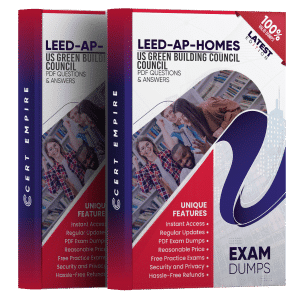USGBC LEED AP Homes Exam Questions 2025
Prepare confidently for the USGBC LEED AP Homes accreditation with Cert Empire’s authentic Exam Questions. Each question is verified by green building experts and paired with accurate answers and a realistic simulator to help you pass on the first attempt
What Users Are Saying:
About LEED‑AP‑Homes Exam
Overview of LEED‑AP‑Homes Exam
As homes across the country adapt to smarter, greener standards, professionals working in residential design, construction, and consulting are expected to catch up. LEED-AP-Homes is the go-to credential if you’re working in housing and want to align with green building expectations. Backed by the U.S. Green Building Council (USGBC) and managed through GBCI, this cert tells the world you understand what goes into building homes that respect environmental standards, resource efficiency, and resident health.
Unlike other LEED paths, this one speaks directly to those working on single-family, low-rise, and mid-rise residential projects. It’s not for generalists. If your job involves green home projects whether you’re an architect, rater, consultant, or builder this cert makes your role official and respected. It covers real-life performance in the field, not just theory.
Who Ends Up Taking This Residential-Focused Credential
The people pursuing LEED-AP-Homes aren’t looking to just expand their resume they’re doing real work that already overlaps with green homes. Professionals like HERS raters, energy modelers, home builders, and project managers in the residential space benefit from this credential the most. Even interior designers working on healthy homes see value in holding this cert.
It’s also a smart move for professionals transitioning from general construction to eco-conscious housing. In 2025, the demand for sustainable living is shaping both consumer expectations and public policy. Having the LEED-AP-Homes badge gives you recognition in housing developments that qualify for green loans, tax incentives, and high-efficiency building credits.
What Kind of Jobs Are You Looking at After Passing This Cert
A LEED-AP-Homes credential isn’t an instant career switch, but it absolutely opens doors. It pairs well with titles like:
- Residential Energy Consultant
- Green Building Specialist
- Project Manager – Sustainable Housing
- Residential LEED Consultant
- Affordable Housing Compliance Officer
- Green Construction Supervisor
And it’s not just job titles it’s what comes with them. Candidates with this cert often find themselves tapped for lead roles in green projects, or selected for municipal and private development contracts that require LEED documentation.
You Learn What Really Matters in Green Housing
LEED-AP-Homes forces professionals to go beyond surface-level sustainability. The technical knowledge you walk away with includes:
- Managing indoor environmental quality in tight residential layouts
- Understanding durability planning for multi-unit homes
- Applying LEED for Homes rating systems to real projects
- Coordinating work with Green Raters and Energy Raters
- Integrating ENERGY STAR for Homes benchmarks
This isn’t a passive badge. It sharpens your approach to construction and design with measurable impact.
What the LEED-AP-Homes Exam Is Really Like
Most people are surprised when they learn this test isn’t the same as other LEED exams. It’s deeply contextual, drawing from field scenarios instead of just abstract LEED principles. You’ll be expected to:
- Match actions with prerequisites and credits
- Evaluate construction decisions using LEED criteria
- Navigate decision-making with credit trade-offs in mind
So, it’s not a memory test. It’s a logic-based, role-playing assessment where your ability to think like a project leader counts more than your ability to memorize numbers.
Syllabus Breakdown and Structure of the LEED-AP-Homes Test
Here’s what the LEED-AP-Homes syllabus (code: LEED-AP-Homes) emphasizes:
|
Domain |
Approximate Weight |
|
LEED Process |
8% |
|
Location and Transportation |
7% |
|
Sustainable Sites |
9% |
|
Water Efficiency |
11% |
|
Energy and Atmosphere |
22% |
|
Materials and Resources |
10% |
|
Indoor Environmental Quality |
17% |
|
Innovation and Regional Priority |
6% |
|
Project Surroundings and Public Outreach |
10% |
The LEED-AP-Homes Test is a computer-based exam offered by GBCI. You get 100 multiple-choice questions and 2 hours to finish it. The passing score isn’t officially disclosed but is assumed to be around 170 out of 200. That number, however, can fluctuate slightly depending on scoring calibrations.
What’s New in 2025 for This Residential LEED Path
The test for 2025 now places more emphasis on affordable housing practices, resilience in housing, and post-pandemic ventilation standards. There’s more attention given to carbon-conscious materials, urban infill developments, and community engagement aspects of home design.
Smart Ways to Get Ready Without Burning Out
You don’t need to become a LEED encyclopedia to pass this exam. Most professionals pass with a solid 4–6 week study schedule. The trick is consistency.
- Week 1–2: Go through LEED reference guides (focus on Homes rating system)
- Week 3–4: Review project documentation examples
- Week 5: Solve full-length LEED-AP-Homes Practice Questions
- Week 6: Focus on weak domains using condensed study aids
Resources You Should Stick With for 2025 Prep
The following LEED-AP-Homes Exam Prep materials are your best bet:
- USGBC LEED for Homes Reference Guide
- GBCI sample questions and handbook
- Real project LEED documentation
- Flashcards for prerequisites and credits
- Supplementary dumps and PDF practice sets from trusted sources
Using a combo of these keeps you sharp on both theory and application.
2 reviews for USGBC LEED AP Homes Exam Questions 2025
Discussions
There are no discussions yet.



Willow Benedict (verified owner) –
I studied for the LEED-AP-Homes exam using practice questions and study resources. They helped me focus on the important topics, making it easier to pass the exam without feeling overwhelmed.
Amber Murray (verified owner) –
After buying LEED-AP-Homes, I received access within minutes. The process was smooth, and I could start revising right away without delays.